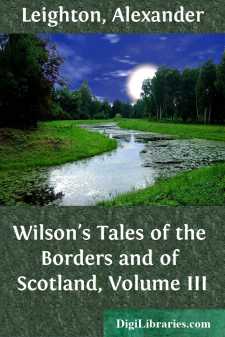Categories
- Antiques & Collectibles 13
- Architecture 36
- Art 48
- Bibles 22
- Biography & Autobiography 813
- Body, Mind & Spirit 142
- Business & Economics 28
- Children's Books 16
- Children's Fiction 13
- Computers 4
- Cooking 94
- Crafts & Hobbies 4
- Drama 346
- Education 46
- Family & Relationships 57
- Fiction 11829
- Games 19
- Gardening 17
- Health & Fitness 34
- History 1377
- House & Home 1
- Humor 147
- Juvenile Fiction 1873
- Juvenile Nonfiction 202
- Language Arts & Disciplines 88
- Law 16
- Literary Collections 686
- Literary Criticism 179
- Mathematics 13
- Medical 41
- Music 40
- Nature 179
- Non-Classifiable 1768
- Performing Arts 7
- Periodicals 1453
- Philosophy 64
- Photography 2
- Poetry 896
- Political Science 203
- Psychology 42
- Reference 154
- Religion 513
- Science 126
- Self-Help 84
- Social Science 81
- Sports & Recreation 34
- Study Aids 3
- Technology & Engineering 59
- Transportation 23
- Travel 463
- True Crime 29
Wilson's Tales of the Borders and of Scotland, Volume III
Description:
Excerpt
THE WIDOW OF DUNSKAITH.
"Oh, mony a shriek, that waefu' night,Rose frae the stormy main;
An' mony a bootless vow was made,
An' mony a prayer vain;
An' mithers wept, an' widows mourned
For mony a weary day;
An' maidens, ance o' blithest mood,
Grew sad, and pined away."
The northern Sutor of Cromarty is of a bolder character than even the southern one—abrupt, and stern, and precipitous as that is. It presents a loftier and more unbroken wall of rock; and, where it bounds on the Moray Frith, there is a savage magnificence in its cliffs and caves, and in the wild solitude of its beach, which we find nowhere equalled on the shores of the other. It is more exposed, too, in the time of tempest: the waves often rise, during the storms of winter, more than a hundred feet against its precipices, festooning them, even at that height, with wreaths of kelp and tangle; and, for miles within the bay, we may hear, at such seasons, the savage uproar that maddens amid its cliffs and caverns, coming booming over the lashings of the nearer waves, like the roar of artillery. There is a sublimity of desolation on its shores, the effects of a conflict maintained for ages, and on a scale so gigantic. The isolated, spire-like crags that rise along its base, are so drilled and bored by the incessant lashings of the surf, and are ground down into shapes so fantastic, that they seem but the wasted skeletons of their former selves; and we find almost every natural fissure in the solid rock hollowed into an immense cavern, whose very ceiling, though the head turns as we look up to it, owes evidently its comparative smoothness to the action of the waves. One of the most remarkable of these recesses occupies what we may term the apex of a lofty promontory. The entrance, unlike that of most of the others, is narrow and rugged, though of great height; but it widens within into a shadowy chamber, perplexed, like the nave of a cathedral, by uncertain cross lights, that come glimmering into it through two lesser openings, which perforate the opposite sides of the promontory. It is a strange, ghostly-looking place; there is a sort of moonlight greenness in the twilight which forms its noon, and the denser shadows which rest along its sides; a blackness, so profound that it mocks the eye, hangs over a lofty passage which leads from it, like a corridor, still deeper into the bowels of the hill; the light falls on a sprinkling of half-buried bones, the remains of animals that, in the depth of winter, have creeped into it for shelter, and to die; and, when the winds are up, and the hoarse roar of the waves comes reverberated from its inner recesses, or creeps howling along its roof, it needs no over-active fancy to people its avenues with the shapes of beings long since departed from every gayer and softer scene, but which still rise uncalled to the imagination in those by-corners of nature which seem dedicated, like this cavern, to the wild, the desolate, and the solitary.
There is a little rocky bay a few hundred yards to the west, which has been known for ages, to all the seafaring men of the place, as the Cova Green. It is such a place as we are sometimes made acquainted with in the narratives of disastrous shipwrecks. First, there is a broad semicircular strip of beach, with a wilderness of insulated piles of rock in front; and so steep and continuous is the wall of precipices which rises behind, that, though we may see directly over head the grassy slopes of the hill, with here and there a few straggling firs, no human foot ever gained the nearer edge. The bay of the Cova Green is a prison to which the sea presents the only outlet; and the numerous caves which open along its sides, like the arches of an amphitheatre, seem but its darker cells. It is, in truth, a wild impressive place, full of beauty and terror, and with none of the squalidness of the mere dungeon about it. There is a puny littleness in our brick and lime receptacles of misery and languor which speaks as audibly of the feebleness of man, as of his crimes or his inhumanity; but here all is great and magnificent—and there is much, too, that is pleasing. Many of the higher cliffs, which rise beyond the influence of the spray, are tapestried with ivy; we may see the heron watching on the ledges beside her bundle of withered twigs, or the blue hawk darting from her cell; there is life on every side of us—life in even the wild tumbling of the waves, and in the stream of pure water which, rushing from the higher edge of the precipice in a long white cord, gradually untwists itself by the way, and spatters ceaselessly among the stones over the entrance of one of the caves....












